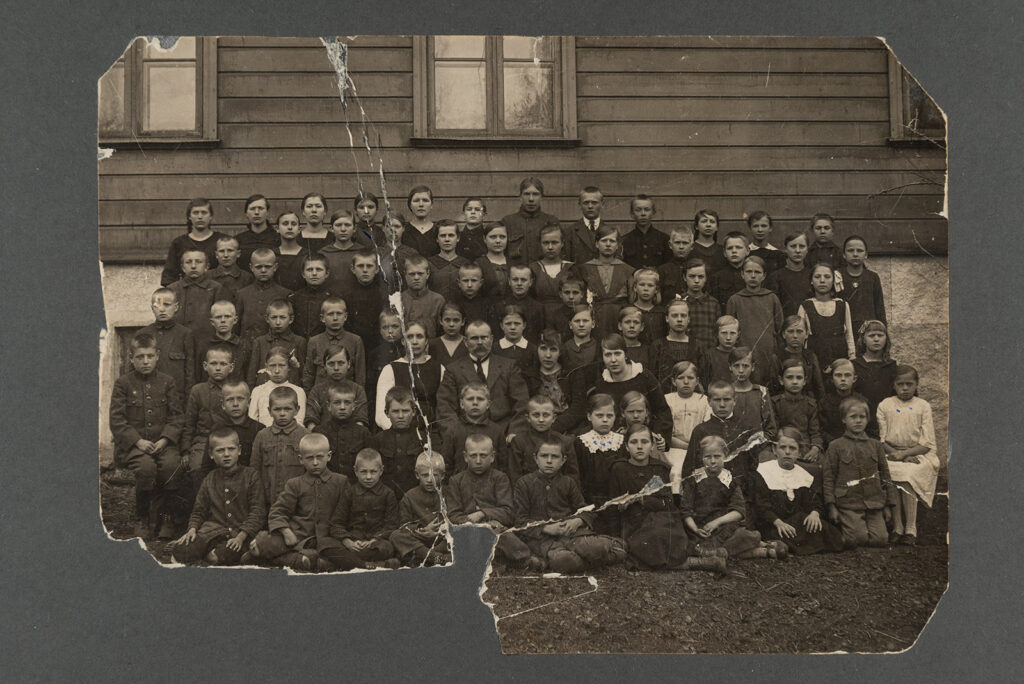Käesoleva lõputöö teemaks oli Heimtali muuseumi fotokogu pappalusel paberfotode konserveerimine. Töö keskendus peamiselt praktilisele konserveerimistööle, mille eesmärgiks oli tagada säilikute edasine säilimine.
Lõputöö kirjalik osa keskendus muuseumite koguges leiduvate pappalusel paberfotode fototehnikate identifitseerimise, seisundi hindamise ja säilitamise põhimõtete tutvustamisel. Neile teadmistele tuginedes uuriti Heimtali fotokogu seisundit MuIS’i keskkonnas ning tutvuda üleslaetud fotomaterjalide põhjal peamiste fototehnikate ja kahjustustega. Heimtali muuseumi fotokogu moodustavad peamiselt säilikud, mis on annetustena või kogumistöö tulemusel muuseumile üle antud või erakogudes olevate fotode koopiatega. Fototehniliselt oli MuIS’i keskkonnas fotod kirjeldatud üksnes “mustvalgete fotodena”, mistõttu oli tehnikate tuvastamine säilitamise huvides ülioluline. Uurimise tulemusel moodustas säilikutest 3 albumiini, 12 kolloodium, 19 kromogeen, 87 POP, 553 DOP ning 2 säiliku kohta puudusid fotokujutised. Fotode seisund kogus oli rahuldav- fotod olid ümbristatud säilikupõhiselt vastavalt formaadile, kuid pakendatud säilikud olid määrdunud pindmise mustuse ja tolmuga, mis tulenes nende kogumise eelsest hoiukeskkonnast. Sageli olid fotod toimetatud muuseumi mahajäetud taluhoonetest, kus need olid seisnud aastaid kui mitte aastakümneid ebasobivates tingimustes niiskuse ja mustuse käes. Fotokogus oli pappalusele vormistatud 78 säilikut, millest postkaarte oli 20. Pappalusel paberfotodest moodustasid enamuse suureformaadilised fotod, mille järgnesid kabinetfotod ja carte de visite’d. Säilikutel esinenud kahjustused olid valdavalt tekkinud käsitsemise ja hoiustamistingumiste tõttu – voolujooned, rebendid, pindmised plekid ja mustus.
Töö praktilises osas tuli säilikutele läheneda materjali põhiselt – papi ja ilupaberi ning fotokujutise konserveerimistööd. Enne parandustöid teostati nii aluspapile kui ka fotokujutisele kuivpuhastus, mille järel oli võimalik taastada papi kihtide vahel olnud liimistust, liimida tagasi eemaldunud ilupaberit, fikseerida rebendeid ja läbimurde, mida vajadusel toestati vastavalt paranduspaberi ja/või loorpaberiga. Fotokujutiste konserveerimisel puhastati kujutise emulsiooni pind poolniiske vatitampooniga, mida niisutati deioniseeritud vees.
Konserveeritud säilikuid tuleb hoida vastava formaadiga fotode säilitamiseks mõeldud ümbristes. Hoidlas tuleks konserveeritud fotosid hoida fototehnika ja formaadi põhiselt grupeerituna, et tagada säilikute maksimaalne säilimine. Samuti tuleb konseveeritud fotosid hoiustada horisontaalselt, et toetuspind oleks kõige suurem.
Enne reaalsete töödega alustamist, tundus pappalusel paberfotode konserveerimine lihtsana, sest paber- ja pappmaterjalid olid tuttavad juba koolis õppimise ajast. Tööde käigus ilmnesid mitmed raskused ja probleemid, mis tõid esile pappalusel paberfotode konserveerimise erinevuse traditsioonilsest paberdokumendist. Materjalide mitmekihilisus ja fotomeediumi tundlikus muutis tööd arvatust keerulisemaks. Väga tähtis on läbi mõelda tööde järjestus, samuti lahuste kasutamisel teostada eelnevad testimised. Hea lõpptulemuse saavutamiseks on oluline tugeva ja stabiilse pressi olemasolu.
The main emphasis of the diploma work was on the practical part. The conservation work took place in the Estonian National Museum in Tartu.
The work is divided into two parts – theoretical and practical. The first parts of this paper are about historical background information about paper photos and early mounted photos. The most common paper based photos are: albumen, collodion and silver gelatin photos. Albumen which is most known two layer structure what means that the image is soaked into paper fibers – in time the emulsion cracks and that is the main indicator of the technique. Two other have three layered structure thanks to under emulsion baryta layer what makes the image brighter and sharper than albumen has. To identify collodion you need to look it under a specific angle, where light creates characteristic rainbow spectre. Silver gelatin photos are divided into two types DOP and POP, that are the mostly commonly known as black and white photo techniques.
Also there are some tips for identifying the main damages based on photo processes. Based on that information the work gives some information how to storage them and how to identify and how to prevent future damages. One the prevental ways to protect storaged photos is by creating suitable environment for storaged photos.
History of Heimtali Museum dates back to 1991, when textile artist Anu Raud joined with Heimtali school museum and created there a textile exhibition room. In years the museum has been expanded. At 2009 Heimtali Musem was gifted to Estonian National Museum by Raud as a gift for all estonians. Today museum includes besides textiles, documents and other artefacts and an impressive photo collection. Collection is mainly based on donations and photocopies of originals from private collection’s. Based on originality there are 520 originals and 137 copies, 18 items were not identified out of 676 photos. Based on photo types there are 3 albumens, 12 collodions, 553 DOP’s and 87 POP’s, two photos were not identified due to unavailable images. Most of the photo collection were paper photos, without cardboard background. There are 78 cardboard photos, 20 of them were photo postcards. Most of mounted photos were not cabinet cards or carte de visite’s. The average mounted paper photo of the collection have a large format. The main damages of mounted photos are – tears, losses, stains, and lack or remains of adhesives.
In the practical part there were restored 8 photos. Two photos were mounted on a new cardboard due to damages on the image. Two photos were partly torn. Two photos were also seriously torn, but there were stained recto papers, what were changed. One photo cardboard was layered and glued back together. One photo cardboard was arched due to tensions. All of the actions were made to ensure that images will be remained.
Photos should be stored in separate envelopes that are made of cotton, linen etc, to ensure that there will be not any chemical processes in time. For example packing a albumen into buffered envelope can lead into serious damages – chemical process that takes part, can speed the aging. It is important to storage photos based on its process and size to in order to protect them. The storage room must be dark and stable. Temperature should be between -10−18° C or lower and air humidity between 30−50%, that can slow the ageing processes. Thanks to that is possible to preserve them at their maximal age. It is elemental to storage different photos based it’s size and photo process.
The objects are usable after the conservation, but handling must still be done with care. As a result, the conservated photos will be handed over to the Heimtali Museum together with recommendations for further care and storage of the objects.











